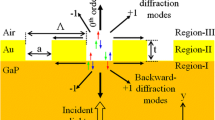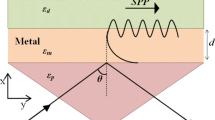Abstract
A numerical transfer matrix method (TMM) is applied to investigate hybrid surface plasmon polaritons (HySPPs) waveguide structure, which consists of a high permittivity dielectric fiber separated from a metal surface with a low permittivity dielectric gap. The results obtained from the TMM agree well with those from the finite element method but with a faster calculation speed. As a demonstration example, we have systematically investigated the propagation properties of the gain-assisted HySPPs waveguide in the terahertz regime by using this method, studying the influences of structure parameters, frequency, temperature, and material gain. The results manifest that the effective index and the propagation loss decrease with the increase of temperature. In addition, as the frequency increases, the effective index increases and the propagation loss shows a peak. Furthermore, lossless propagation can be achieved when certain gain materials are applied into the HySPPs structure. Our method provides an efficient approach to investigate HySPPs waveguide and other plasmonic devices.






Similar content being viewed by others
References
Raether H (1988) Surface plasmons on smooth and rough surfaces and on gratings. Springer, Berlin
Barnes WL, Dereux A, Ebbesen TW (2003) Surface plasmon subwavelength optics. Nature 424(6950):824–830
Wang QJ, Yan C, Diehl L, Hentschel M, Wiersig J, Yu N, Pflügl C, Belkin MA, Edamura T, Yamanishi M, Kan H, Capasso F (2009) Deformed microcavity quantum cascade lasers with directional emission. New J Phys 11(12):125018
Li XF, Yu SF (2010) Extremely high sensitive plasmonic refractive index sensors based on metallic grating. Plasmonics 5(4):389–394
Bozhevolnyi SI, Volkov VS, Devaux E, Laluet JY, Ebbesen TW (2006) Channel plasmon subwavelength waveguide components including interferometers and ring resonators. Nature 440(7083):508–511
Grandidier J, Massenot S, des Francs GC, Bouhelier A, Weeber JC, Markey L, Dereux A, Renger J, González MU, Quidant R (2008) Dielectric-loaded surface plasmon polariton waveguides: figures of merit and mode characterization by image and Fourier plane leakage microscopy. Phys Rev B 78(24):245419
Veronis G, Fan SH (2005) Bends and splitters in metal-dielectric-metal subwavelength plasmonic waveguides. Appl Phys Lett 87(13):131102
He XY (2009) Numerical analysis of the propagation properties of subwavelength semiconductor slit in the terahertz region. Opt Express 17(17):15359–15371
Oulton RF, Sorger VJ, Genov DA, Pile DFP, Zhang X (2008) A hybrid plasmonic waveguide for subwavelength confinement and long-range propagation. Nat Photonics 2(8):496–500
Oulton RF, Sorger VJ, Zentgraf T, Ma RM, Gladden C, Dai L, Bartal G, Zhang X (2009) Plasmon lasers at deep subwavelength scale. Nature 461(7264):629–632
Zhang J, Cai L, Bai W, Xu Y, Song G (2011) Hybrid plasmonic waveguide with gain medium for lossless propagation with nanoscale confinement. Opt Lett 36(12):2312–2314
Zheng YJ, Liu H, Wang SM, Li T, Cao JX, Li L, Zhu C, Wang Y, Zhu SN, Zhang X (2011) Selective optical trapping based on strong plasmonic coupling between gold nanorods and slab. Appl Phys Lett 98(8):083117
Yang XD, Liu YM, Oulton RF, Yin XB, Zhang X (2011) Optical forces in hybrid plasmonic waveguides. Nano Lett 11(2):321–328
Ta VD, Chen R, Sun HD (2011) Wide-range coupling between surface plasmon polariton and cylindrical dielectric waveguide mode. Opt Express 19(14):13598–13603
Zou CL, Sun FW, Xiao YF, Dong CH, Chen XD, Cui JM, Gong Q, Han ZF, Guo GC (2010) Plasmon modes of silver nanowire on a silica substrate. Appl Phys Lett 97(18):183102
Wang X, Belyanin AA, Crooker SA, Mittleman DM, Kono J (2010) Interference-induced terahertz transparency in a semiconductor magneto-plasma. Nat Phys 6(2):126–130
Wang QJ, Yan C, Yu N, Unterhinninghofen J, Wiersig J, Pflügl C, Diehl L, Edamurac T, Yamanishi M, Kan H, Capasso F (2010) Whispering-gallery mode resonators for highly unidirectional laser action. PNAS 107(52):22407–22412
Cao JC (2003) Interband impact ionization and nonlinear absorption of terahertz radiation in semiconductor heterostructures. Phys Rev Lett 91(23):237401
Yu NF, Wang QJ, Kats MA, Fan FA, Khanna SP, Li LH, Davies AG, Linfield EH, Capasso F (2010) Designer spoof surface plasmon structures collimate terahertz laser beams. Nat Mater 9(9):730–735
Singh R, Rockstuhl C, Lederer F, Zhang WL (2009) Coupling between a dark and a bright eigenmode in a terahertz metamaterial. Phys Rev B 79(8):085111
Wright AR, Cao JC, Zhang C (2009) Enhanced optical conductivity of bilayer grapheme nanoribbons in the terahertz regime. Phys Rev Lett 103(20):207401
Wang KL, Mittleman DM (2004) Metal wires for terahertz wave guiding. Nature 432(7015):376–379
Wang KL, Mittleman DM (2006) Dispersion of surface plasmon polaritons on metal wires in the terahertz frequency range. Phys Rev Lett 96(15):157401
He XY (2009) Investigation of terahertz Sommerfeld wave propagation along conical metal wire. J Opt Soc Am B 26(9):A23–A28
He XY (2010) Investigation of terahertz surface waves of a metallic nanowire. J Opt Soc Am B 27(11):2298–2303
Snyder AW, Love JD (1983) Optical waveguide theory. Chapman & Hall, New York
Yang F, Sambles JR, Bradberry GW (1991) Long-range surface modes supported by thin films. Phys Rev B 44(11):5855–5872
Lü JT, Cao JC (2006) Confined optical phonon modes and electron-phonon interactions in wurtzite GaN/ZnO quantum wells. Phys Rev B 73(19):195326
Ordal MA, Bell RJ, Alexander RW, Long LL, Querry MR (1985) Optical properties of fourteen metals in the infrared and far infrared: Al, Co, Cu, Au, Fe, Pb, Mo, Ni, Pd, Pt, Ag, Ti, V, and W. Appl Opt 24(24):4493–4499
Azad AK, Zhao Y, Zhang WL (2005) Transmission properties of terahertz pulses through an ultrathin subwavelength silicon hole array. Appl Phys Lett 86(14):141102
Vinh NQ, Ha NN, Gregorkiewicz T (2007) Photonic properties of Er-doped crystalline silicon. Proc IEEE 97(7):1269–1283
Adam TN, Troeger RT, Ray SK, Lü PC, Kolodzeya J (2003) Terahertz electroluminescence from boron-doped silicon devices. Appl Phys Lett 83(9):1713–1715
Pavlov SG, Zhukavin RK, Orlova EE, Shastin VN, Kirsanov AV, Hübers HW, Auen K, Riemann H (2000) Stimulated emission from donor transitions in silicon. Phys Rev Lett 84(22):5220–5223
Rana F (2008) Graphene terahertz plasmon oscillators. IEEE Trans Nanotechnol 7(1):91–99
Li DB, Ning CZ (2009) Giant modal gain, amplified surface plasmon-polariton propagation, and slowing down of energy velocity in a metal-semiconductor-metal structure. Phys Rev B 80(15):153304
Acknowledgments
This work is supported by A*STAR SERC under grant no. 082-101-0016 and Nanyang Technological University, Singapore, under grant no. M58040017. HE XY would like to thank Mr. Tao Liu for many helpful discussions.
Author information
Authors and Affiliations
Corresponding author
Rights and permissions
About this article
Cite this article
He, X.Y., Wang, Q.J. & Yu, S.F. Numerical Study of Gain-Assisted Terahertz Hybrid Plasmonic Waveguide. Plasmonics 7, 571–577 (2012). https://doi.org/10.1007/s11468-012-9344-6
Received:
Accepted:
Published:
Issue Date:
DOI: https://doi.org/10.1007/s11468-012-9344-6




